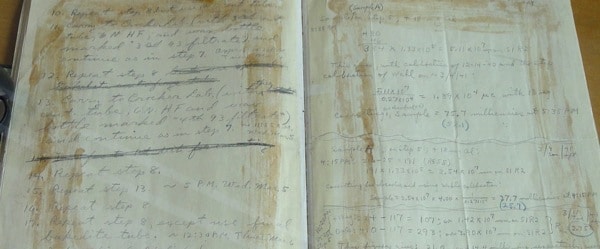Several steps are required when preparing a sample for histology. We’ve covered these steps in brief in a previous article on How Histology Slides are Prepared, but this article will focus on one particular procedure that needs to take place between tissue fixation and the embedding/sectioning of paraffin blocks: tissue processing for histology.
You can’t simply take fixed tissue and embed it! We have already introduced tissue fixation and tissue embedding/sectioning previously, so please read those articles for more information on the other steps involved in tissue preparation.
Here, we focus on this in-between stage of conventional tissue processing for histology.
6 Steps of Histology Tissue Processing
1. Get Your Pencil Out
Following fixation, the tissue sample is transferred to a tissue cassette. These cassettes, which come in various sizes, hold and protect the tissue while it undergoes processing.
Once the embedding stage is reached, the cassette lid is snapped off, and the main part of the cassette forms a base for the paraffin wax block. The cassettes can be labeled by hand (with a pencil!), or your histology lab may have a cassette labeling machine.
There are three main steps in tissue processing: ‘dehydration’, ‘clearing’, and ‘infiltration’. Each step involves the diffusion of a solution into tissue and the dispersion of the previous solution in the series.
2. All the Fun of the Carousel
In most modern institutes and labs, tissue processing for histology is carried out in dedicated tissue processing machines. The older design of machine is a carousel, which contains a cage where the tissue cassettes are placed.
This carousel has a number of glass beakers containing solvents and solutions that ensure the tissue is dehydrated and cleared, ready for paraffin wax embedding. The carousel vertically agitates the cage in each solution before moving on to the next solution in the dehydration/clearing method.
The modern processors have a chamber in which the specimens are held, and the different solutions are pumped in and out of the chamber. In general, the whole process takes around six hours and is usually set up to run overnight.
3. First, Remove the Water
First, the tissue needs to be dehydrated to remove the water, which is present either free or bound to the tissue. Paraffin wax is hydrophobic; therefore, most of the water in the tissue must be removed before it can be infiltrated with wax.
Removing the water is carried out by immersing tissue in a series of ethanol solutions of increasing concentrations until 100% water-free alcohol is reached. This series of increasing concentrations ensures that the water in the tissue is gradually replaced by the alcohol and avoids excessive distortion of the tissue.
Various components of the cell are also removed by this process. At the lower end of the ethanol concentrations, water-soluble proteins are removed, while towards the 100% ethanol step, certain lipids may be dissolved.
4. Ethanol and Wax Don’t Mix
Although the tissue reaches the final stage of dehydration in 100% ethanol, it’s not possible to proceed straight to wax embedding, as ethanol and wax don’t mix!
This is where tissue clearing comes in. The term clearing refers to the property of the solvents used—they have a relatively high refractive index, and when tissue is immersed in it, it becomes transparent and clear.
5. It’s Becoming Clearer…
The solvent used for this intermediate stage is usually xylene. The ‘clearing agent’ needs to be miscible with both ethanol and paraffin wax.
Following dehydration, the tissue is immersed in one to three different xylene immersions. In these stages, the ethanol is gradually replaced with xylene, and when the tissue is embedded, the xylene will be replaced by the molten paraffin wax.
Shrinkage of tissue can occur at these final stages as the xylene also removes fat residues left in the samples.
6. At Last – A Block!
The final stages are called ‘infiltration’ and ‘blocking out’. Infiltration is when the final xylene is replaced with molten wax, which infiltrates the tissue. Again, this is typically three different wax immersions to ensure that none of the clearing agent remains in the tissue.
After the final infiltration, the tissue cassettes are transferred to an embedding station. This machine has reservoirs of molten wax, hotplates, and a cold plate for setting the tissue blocks.
The infiltrated tissue is removed from the cassette and orientated within a suitably sized metal mold. The mold is filled with molten wax, the main part of the labeled cassette is placed on top, and this is also filled with wax. The whole mold is transferred to the cold plate to finally set.
That ends the journey from tissue to wax block, which is, I guess, the start of another journey of sectioning, making slides, and immunohistochemistry!
Finally, below is a table that highlights the typical main stages of tissue processing for histology.
Table 1. Main stages of tissue processing for histology.
| Process | Solution | Time |
|---|---|---|
| Dehydration | 70% alcohol | 60 mins |
| Dehydration | 90% alcohol | 45 mins |
| Dehydration | Absolute alcohol | 45 mins |
| Dehydration | Absolute alcohol | 45 mins |
| Dehydration | Absolute alcohol | 60 mins |
| Clearing | Xylene | 60 mins |
| Clearing | Xylene | 60 mins |
| Clearing | Xylene | 60 mins |
| Infiltration | Paraffin wax | 30 mins |
| Infiltration | Paraffin wax | 60 mins |
| Infiltration | Paraffin wax | 90 mins |
| Blocking Out | Paraffin wax | n/a |
Tissue Processing for Histology Summarized
That’s an overview of tissue processing for histology, highlighting the critical steps—dehydration, clearing, and infiltration—to prepare a tissue sample from fixation to embedding in paraffin wax.
Do you have any questions about tissue processing for histology microscopy? Leave a comment below!
Want to know more about histology? Visit the Bitesize Bio Histology Hub for tips and tricks for all your histology experiments. You might also be interested in the later steps of sample prep for histology, which are covered in our eBook guide to special stains in histology, and immunohistochemical staining article.
And if you’re wondering what histological stain will stain the tissue you’re interested in? Download our free, colorful guide to histological stains and pin it up.
FAQs
Q: What specific criteria are used to determine the appropriate size and type of tissue cassette for different tissue samples?
A: The appropriate size and type of tissue cassette for different tissue samples are typically determined based on the size and delicacy of the tissue itself. Larger or more robust tissues may require sturdier or larger cassettes, while delicate tissues need cassettes that offer more protection and minimal handling. The selection is crucial to prevent damage during processing and to ensure that the tissue remains intact and properly oriented throughout the procedure.
Q: How do the specific concentrations of ethanol in the dehydration process affect the quality and integrity of the tissue sample?
A: The specific concentrations of ethanol used in the dehydration process are designed to progressively replace water in the tissue with alcohol, preventing abrupt changes that could cause tissue distortion or damage. Lower concentrations of ethanol remove the bulk of the water, preparing the tissue for higher concentrations. As the ethanol concentration increases, it gradually replaces more water, ensuring a smooth transition to absolute alcohol without causing the tissue to shrink or warp excessively.
Q: What are the potential effects of xylene substitutes (if any are used) on tissue clearing and the overall histology tissue processing outcomes compared to using xylene?
A: Regarding xylene substitutes, various alternatives like limonene-based clearants are used to reduce the health and safety risks associated with xylene. These substitutes must be miscible with both alcohol and paraffin wax, similar to xylene, to ensure effective clearing. The impact of these substitutes on tissue processing outcomes can vary; while they are generally effective, some may alter tissue morphology slightly or affect processing times. The choice of substitute often depends on the specific requirements of the histological analysis and the preferences of the laboratory regarding safety and environmental impact.
Originally published December 10, 2013. Reviewed and updated in October 2021 and April 2024.
Check out the latest episode of The Microscopists podcast to hear from leaders in the microscopy world:







